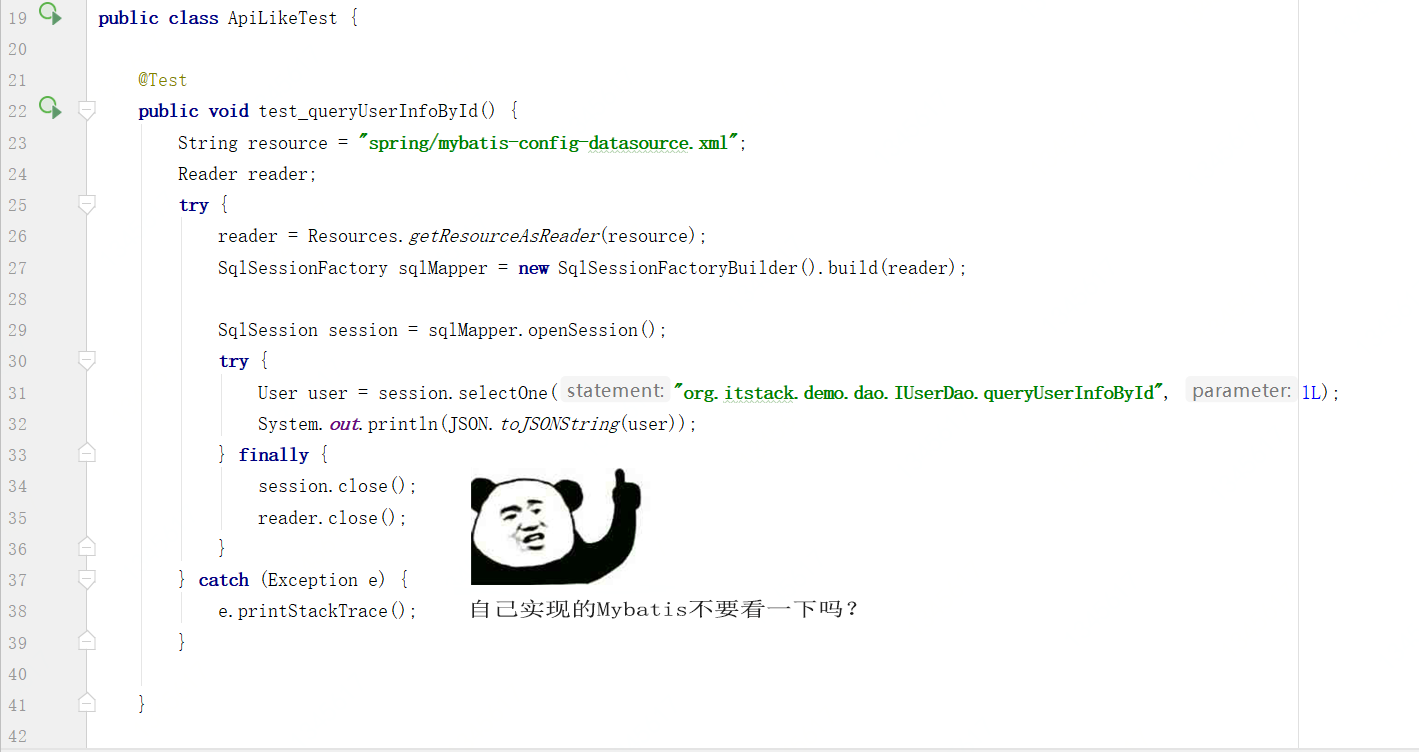-
Notifications
You must be signed in to change notification settings - Fork 3.8k
2020 01 13 [源码分析]基于jdbc实现一个Demo版的Mybatis
作者:小傅哥
博客:https://bugstack.cn - 原创系列专题
沉淀、分享、成长,让自己和他人都能有所收获!
微信公众号:bugstack虫洞栈 | 博客:https://bugstack.cn
沉淀、分享、成长,专注于原创专题案例,以最易学习编程的方式分享知识,让自己和他人都能有所收获。目前已完成的专题有;Netty4.x实战专题案例、用Java实现JVM、基于JavaAgent的全链路监控、手写RPC框架、架构设计专题案例、源码分析等。
你用剑🗡、我用刀🔪,好的代码都很烧😏,望你不吝出招💨!
在前面一篇分析了 mybatis 源码,从它为什么之后接口但是没有实现类就能执行数据库操作为入口,整个源码核心流程完全解释了一遍。对于一个3年以上的程序员来说,新知识的学习过程应该是从最开始 helloworld 到熟练使用 api 完成业务功能。下一步为了深入了解就需要阅读部分核心源码,从而在出问题后可以快速定位,迅速排查。从而减少线上事故的持续时长,提升个人影响力。但!这不是学习终点,因为无论是任何一个框架的源码,如果只是看那么就很难学习到它的实用技术。纸上得来终觉浅,唯有实战和操练。
那么,本章节我们去简单实现一个基于jdbc的demo版本Mybatis,从而更加清楚这样框架的设计。与此同时这份思想会让你可以在其他场景使用,比如给ES查询写一个EsBatis。实现了心情也好了;
扩展上一篇源码分析工程;itstack-demo-mybatis,增加 like 包,模仿 Mybatis 工程。完整规程下载,关注公众号:bugstack虫洞栈 | 回复:源码分析
itstack-demo-mybatis
└── src
├── main
│ ├── java
│ │ └── org.itstack.demo
│ │ ├── dao
│ │ │ ├── ISchool.java
│ │ │ └── IUserDao.java
│ │ ├── like
│ │ │ ├── Configuration.java
│ │ │ ├── DefaultSqlSession.java
│ │ │ ├── DefaultSqlSessionFactory.java
│ │ │ ├── Resources.java
│ │ │ ├── SqlSession.java
│ │ │ ├── SqlSessionFactory.java
│ │ │ ├── SqlSessionFactoryBuilder.java
│ │ │ └── SqlSessionFactoryBuilder.java
│ │ └── interfaces
│ │ ├── School.java
│ │ └── User.java
│ ├── resources
│ │ ├── mapper
│ │ │ ├── School_Mapper.xml
│ │ │ └── User_Mapper.xml
│ │ ├── props
│ │ │ └── jdbc.properties
│ │ ├── spring
│ │ │ ├── mybatis-config-datasource.xml
│ │ │ └── spring-config-datasource.xml
│ │ ├── logback.xml
│ │ ├── mybatis-config.xml
│ │ └── spring-config.xml
│ └── webapp
│ └── WEB-INF
└── test
└── java
└── org.itstack.demo.test
├── ApiLikeTest.java
├── MybatisApiTest.java
└── SpringApiTest.java- JDK1.8
- IDEA 2019.3.1
- dom4j 1.6.1
关于整个 Demo 版本,并不是把所有 Mybatis 全部实现一遍,而是拨丝抽茧将最核心的内容展示给你,从使用上你会感受一模一样,但是实现类已经全部被替换,核心类包括;
- Configuration
- DefaultSqlSession
- DefaultSqlSessionFactory
- Resources
- SqlSession
- SqlSessionFactory
- SqlSessionFactoryBuilder
- XNode
ApiLikeTest.test_queryUserInfoById()
@Test
public void test_queryUserInfoById() {
String resource = "spring/mybatis-config-datasource.xml";
Reader reader;
try {
reader = Resources.getResourceAsReader(resource);
SqlSessionFactory sqlMapper = new SqlSessionFactoryBuilder().build(reader);
SqlSession session = sqlMapper.openSession();
try {
User user = session.selectOne("org.itstack.demo.dao.IUserDao.queryUserInfoById", 1L);
System.out.println(JSON.toJSONString(user));
} finally {
session.close();
reader.close();
}
} catch (Exception e) {
e.printStackTrace();
}
}一切顺利结果如下(新人往往会遇到各种问题);
{"age":18,"createTime":1576944000000,"id":1,"name":"水水","updateTime":1576944000000}
Process finished with exit code 0可能乍一看这测试类完全和 MybatisApiTest.java 测试的代码一模一样呀,也看不出区别。其实他们的引入的包是不一样;
MybatisApiTest.java 里面引入的包
import org.apache.ibatis.io.Resources;
import org.apache.ibatis.session.SqlSession;
import org.apache.ibatis.session.SqlSessionFactory;
import org.apache.ibatis.session.SqlSessionFactoryBuilder;ApiLikeTest.java 里面引入的包
import org.itstack.demo.like.Resources;
import org.itstack.demo.like.SqlSession;
import org.itstack.demo.like.SqlSessionFactory;
import org.itstack.demo.like.SqlSessionFactoryBuilder;好!接下来我们开始分析这部分核心代码。
这里我们采用 mybatis 的配置文件结构进行解析,在不破坏原有结构的情况下,最大可能的贴近源码。mybatis 单独使用的使用的时候使用了两个配置文件;数据源配置、Mapper 映射配置,如下;
mybatis-config-datasource.xml & 数据源配置
<?xml version="1.0" encoding="UTF-8"?>
<!DOCTYPE configuration PUBLIC "-//mybatis.org//DTD Config 3.0//EN"
"http://mybatis.org/dtd/mybatis-3-config.dtd">
<configuration>
<environments default="development">
<environment id="development">
<transactionManager type="JDBC"/>
<dataSource type="POOLED">
<property name="driver" value="com.mysql.jdbc.Driver"/>
<property name="url" value="jdbc:mysql://127.0.0.1:3306/itstack?useUnicode=true"/>
<property name="username" value="root"/>
<property name="password" value="123456"/>
</dataSource>
</environment>
</environments>
<mappers>
<mapper resource="mapper/User_Mapper.xml"/>
<mapper resource="mapper/School_Mapper.xml"/>
</mappers>
</configuration>User_Mapper.xml & Mapper 映射配置
<?xml version="1.0" encoding="UTF-8"?>
<!DOCTYPE mapper PUBLIC "-//mybatis.org//DTD Mapper 3.0//EN" "http://mybatis.org/dtd/mybatis-3-mapper.dtd">
<mapper namespace="org.itstack.demo.dao.IUserDao">
<select id="queryUserInfoById" parameterType="java.lang.Long" resultType="org.itstack.demo.po.User">
SELECT id, name, age, createTime, updateTime
FROM user
where id = #{id}
</select>
<select id="queryUserList" parameterType="org.itstack.demo.po.User" resultType="org.itstack.demo.po.User">
SELECT id, name, age, createTime, updateTime
FROM user
where age = #{age}
</select>
</mapper>这里的加载过程与 mybaits 不同,我们采用 dom4j 方式。在案例中会看到最开始获取资源,如下;
ApiLikeTest.test_queryUserInfoById() & 部分截取
String resource = "spring/mybatis-config-datasource.xml";
Reader reader;
try {
reader = Resources.getResourceAsReader(resource);
...从上可以看到这是通过配置文件地址获取到了读取流的过程,从而为后面解析做基础。首先我们先看 Resources 类,整个是我们的资源类。
Resources.java & 资源类
/**
* 公众号 | bugstack虫洞栈
* 博 客 | https://bugstack.cn
* Create by 小傅哥 @2020
*/
public class Resources {
public static Reader getResourceAsReader(String resource) throws IOException {
return new InputStreamReader(getResourceAsStream(resource));
}
private static InputStream getResourceAsStream(String resource) throws IOException {
ClassLoader[] classLoaders = getClassLoaders();
for (ClassLoader classLoader : classLoaders) {
InputStream inputStream = classLoader.getResourceAsStream(resource);
if (null != inputStream) {
return inputStream;
}
}
throw new IOException("Could not find resource " + resource);
}
private static ClassLoader[] getClassLoaders() {
return new ClassLoader[]{
ClassLoader.getSystemClassLoader(),
Thread.currentThread().getContextClassLoader()};
}
}这段代码方法的入口是getResourceAsReader,直到往下以此做了;
- 获取 ClassLoader 集合,最大限度搜索配置文件
- 通过 classLoader.getResourceAsStream 读取配置资源,找到后立即返回,否则抛出异常
配置文件加载后开始进行解析操作,这里我们也仿照 mybatis 但进行简化,如下;
SqlSessionFactory sqlMapper = new SqlSessionFactoryBuilder().build(reader);SqlSessionFactoryBuilder.build() & 入口构建类
public DefaultSqlSessionFactory build(Reader reader) {
SAXReader saxReader = new SAXReader();
try {
Document document = saxReader.read(new InputSource(reader));
Configuration configuration = parseConfiguration(document.getRootElement());
return new DefaultSqlSessionFactory(configuration);
} catch (DocumentException e) {
e.printStackTrace();
}
return null;
}- 通过读取流创建 xml 解析的 Document 类
- parseConfiguration 进行解析 xml 文件,并将结果设置到配置类中,包括;连接池、数据源、mapper关系
SqlSessionFactoryBuilder.parseConfiguration() & 解析过程
private Configuration parseConfiguration(Element root) {
Configuration configuration = new Configuration();
configuration.setDataSource(dataSource(root.selectNodes("//dataSource")));
configuration.setConnection(connection(configuration.dataSource));
configuration.setMapperElement(mapperElement(root.selectNodes("mappers")));
return configuration;
}- 在前面的 xml 内容中可以看到,我们需要解析出数据库连接池信息 datasource,还有数据库语句映射关系 mappers
SqlSessionFactoryBuilder.dataSource() & 解析出数据源
private Map<String, String> dataSource(List<Element> list) {
Map<String, String> dataSource = new HashMap<>(4);
Element element = list.get(0);
List content = element.content();
for (Object o : content) {
Element e = (Element) o;
String name = e.attributeValue("name");
String value = e.attributeValue("value");
dataSource.put(name, value);
}
return dataSource;
}- 这个过程比较简单,只需要将数据源信息获取即可
SqlSessionFactoryBuilder.connection() & 获取数据库连接
private Connection connection(Map<String, String> dataSource) {
try {
Class.forName(dataSource.get("driver"));
return DriverManager.getConnection(dataSource.get("url"), dataSource.get("username"), dataSource.get("password"));
} catch (ClassNotFoundException | SQLException e) {
e.printStackTrace();
}
return null;
}- 这个就是jdbc最原始的代码,获取了数据库连接池
SqlSessionFactoryBuilder.mapperElement() & 解析SQL语句
private Map<String, XNode> mapperElement(List<Element> list) {
Map<String, XNode> map = new HashMap<>();
Element element = list.get(0);
List content = element.content();
for (Object o : content) {
Element e = (Element) o;
String resource = e.attributeValue("resource");
try {
Reader reader = Resources.getResourceAsReader(resource);
SAXReader saxReader = new SAXReader();
Document document = saxReader.read(new InputSource(reader));
Element root = document.getRootElement();
//命名空间
String namespace = root.attributeValue("namespace");
// SELECT
List<Element> selectNodes = root.selectNodes("select");
for (Element node : selectNodes) {
String id = node.attributeValue("id");
String parameterType = node.attributeValue("parameterType");
String resultType = node.attributeValue("resultType");
String sql = node.getText();
// ? 匹配
Map<Integer, String> parameter = new HashMap<>();
Pattern pattern = Pattern.compile("(#\\{(.*?)})");
Matcher matcher = pattern.matcher(sql);
for (int i = 1; matcher.find(); i++) {
String g1 = matcher.group(1);
String g2 = matcher.group(2);
parameter.put(i, g2);
sql = sql.replace(g1, "?");
}
XNode xNode = new XNode();
xNode.setNamespace(namespace);
xNode.setId(id);
xNode.setParameterType(parameterType);
xNode.setResultType(resultType);
xNode.setSql(sql);
xNode.setParameter(parameter);
map.put(namespace + "." + id, xNode);
}
} catch (Exception ex) {
ex.printStackTrace();
}
}
return map;
}- 这个过程首先包括是解析所有的sql语句,目前为了测试只解析 select 相关
- 所有的 sql 语句为了确认唯一,都是使用;namespace + select中的id进行拼接,作为 key,之后与sql一起存放到 map 中。
- 在 mybaits 的 sql 语句配置中,都有占位符,用于传参。where id = #{id} 所以我们需要将占位符设置为问号,另外需要将占位符的顺序信息与名称存放到 map 结构,方便后续设置查询时候的入参。
最后将初始化后的配置类 Configuration,作为参数进行创建 DefaultSqlSessionFactory,如下;
public DefaultSqlSessionFactory build(Reader reader) {
SAXReader saxReader = new SAXReader();
try {
Document document = saxReader.read(new InputSource(reader));
Configuration configuration = parseConfiguration(document.getRootElement());
return new DefaultSqlSessionFactory(configuration);
} catch (DocumentException e) {
e.printStackTrace();
}
return null;
}DefaultSqlSessionFactory.java & SqlSessionFactory的实现类
public class DefaultSqlSessionFactory implements SqlSessionFactory {
private final Configuration configuration;
public DefaultSqlSessionFactory(Configuration configuration) {
this.configuration = configuration;
}
@Override
public SqlSession openSession() {
return new DefaultSqlSession(configuration.connection, configuration.mapperElement);
}
}- 这个过程比较简单,构造函数只提供了配置类入参
- 实现 SqlSessionFactory 的 openSession(),用于创建 DefaultSqlSession,也就可以执行 sql 操作
SqlSession session = sqlMapper.openSession();上面这一步就是创建了DefaultSqlSession,比较简单。如下;
@Override
public SqlSession openSession() {
return new DefaultSqlSession(configuration.connection, configuration.mapperElement);
}User user = session.selectOne("org.itstack.demo.dao.IUserDao.queryUserInfoById", 1L);在 DefaultSqlSession 中通过实现 SqlSession,提供数据库语句查询和关闭连接池,如下;
SqlSession.java & 定义
public interface SqlSession {
<T> T selectOne(String statement);
<T> T selectOne(String statement, Object parameter);
<T> List<T> selectList(String statement);
<T> List<T> selectList(String statement, Object parameter);
void close();
}接下来看具体的执行过程,session.selectOne
DefaultSqlSession.selectOne() & 执行查询
public <T> T selectOne(String statement, Object parameter) {
XNode xNode = mapperElement.get(statement);
Map<Integer, String> parameterMap = xNode.getParameter();
try {
PreparedStatement preparedStatement = connection.prepareStatement(xNode.getSql());
buildParameter(preparedStatement, parameter, parameterMap);
ResultSet resultSet = preparedStatement.executeQuery();
List<T> objects = resultSet2Obj(resultSet, Class.forName(xNode.getResultType()));
return objects.get(0);
} catch (Exception e) {
e.printStackTrace();
}
return null;
}-
selectOne 就objects.get(0);,selectList 就全部返回
-
通过 statement 获取最初解析 xml 时候的存储的 select 标签信息;
<select id="queryUserInfoById" parameterType="java.lang.Long" resultType="org.itstack.demo.po.User"> SELECT id, name, age, createTime, updateTime FROM user where id = #{id} </select>
-
获取 sql 语句后交给 jdbc 的 PreparedStatement 类进行执行
-
这里还需要设置入参,我们将入参设置进行抽取,如下;
private void buildParameter(PreparedStatement preparedStatement, Object parameter, Map<Integer, String> parameterMap) throws SQLException, IllegalAccessException { int size = parameterMap.size(); // 单个参数 if (parameter instanceof Long) { for (int i = 1; i <= size; i++) { preparedStatement.setLong(i, Long.parseLong(parameter.toString())); } return; } if (parameter instanceof Integer) { for (int i = 1; i <= size; i++) { preparedStatement.setInt(i, Integer.parseInt(parameter.toString())); } return; } if (parameter instanceof String) { for (int i = 1; i <= size; i++) { preparedStatement.setString(i, parameter.toString()); } return; } Map<String, Object> fieldMap = new HashMap<>(); // 对象参数 Field[] declaredFields = parameter.getClass().getDeclaredFields(); for (Field field : declaredFields) { String name = field.getName(); field.setAccessible(true); Object obj = field.get(parameter); field.setAccessible(false); fieldMap.put(name, obj); } for (int i = 1; i <= size; i++) { String parameterDefine = parameterMap.get(i); Object obj = fieldMap.get(parameterDefine); if (obj instanceof Short) { preparedStatement.setShort(i, Short.parseShort(obj.toString())); continue; } if (obj instanceof Integer) { preparedStatement.setInt(i, Integer.parseInt(obj.toString())); continue; } if (obj instanceof Long) { preparedStatement.setLong(i, Long.parseLong(obj.toString())); continue; } if (obj instanceof String) { preparedStatement.setString(i, obj.toString()); continue; } if (obj instanceof Date) { preparedStatement.setDate(i, (java.sql.Date) obj); } } }
- 单个参数比较简单直接设置值即可,Long、Integer、String ...
- 如果是一个类对象,需要通过获取 Field 属性,与参数 Map 进行匹配设置
-
设置参数后执行查询 preparedStatement.executeQuery()
-
接下来需要将查询结果转换为我们的类(主要是反射类的操作),resultSet2Obj(resultSet, Class.forName(xNode.getResultType()));
private <T> List<T> resultSet2Obj(ResultSet resultSet, Class<?> clazz) { List<T> list = new ArrayList<>(); try { ResultSetMetaData metaData = resultSet.getMetaData(); int columnCount = metaData.getColumnCount(); // 每次遍历行值 while (resultSet.next()) { T obj = (T) clazz.newInstance(); for (int i = 1; i <= columnCount; i++) { Object value = resultSet.getObject(i); String columnName = metaData.getColumnName(i); String setMethod = "set" + columnName.substring(0, 1).toUpperCase() + columnName.substring(1); Method method; if (value instanceof Timestamp) { method = clazz.getMethod(setMethod, Date.class); } else { method = clazz.getMethod(setMethod, value.getClass()); } method.invoke(obj, value); } list.add(obj); } } catch (Exception e) { e.printStackTrace(); } return list; }
- 主要通过反射生成我们的类对象,这个类的类型定义在 sql 标签上
- 时间类型需要判断后处理,Timestamp,与 java 不是一个类型
sql 查询有入参、有不需要入参、有查询一个、有查询集合,只需要合理包装即可,例如下面的查询集合,入参是对象类型;
ApiLikeTest.test_queryUserList()
@Test
public void test_queryUserList() {
String resource = "spring/mybatis-config-datasource.xml";
Reader reader;
try {
reader = Resources.getResourceAsReader(resource);
SqlSessionFactory sqlMapper = new SqlSessionFactoryBuilder().build(reader);
SqlSession session = sqlMapper.openSession();
try {
User req = new User();
req.setAge(18);
List<User> userList = session.selectList("org.itstack.demo.dao.IUserDao.queryUserList", req);
System.out.println(JSON.toJSONString(userList));
} finally {
session.close();
reader.close();
}
} catch (Exception e) {
e.printStackTrace();
}
}**测试结果:
[{"age":18,"createTime":1576944000000,"id":1,"name":"水水","updateTime":1576944000000},{"age":18,"createTime":1576944000000,"id":2,"name":"豆豆","updateTime":1576944000000}]
Process finished with exit code 0- 学习完 Mybaits 核心源码,再实现一下核心过程,那么就会很清晰这个过程是怎么个流程,也就不会觉得自己知识栈有漏洞
- 只有深入的学习才能将这样的技术赋能于其他开发上,例如给ES增加这样查询包,让ES更加容易操作。其实还可以有很多创造
- 知识往往是综合的使用,将各个知识点综合起来使用,才能更加熟练。不要总看不做,否则全套的流程不能在自己脑子流程下什么印象
小傅哥 | 沉淀、分享、成长,让自己和他人都能有所收获!
小傅哥(微信:fustack),公众号:bugstack虫洞栈 | bugstack.cn - 沉淀、分享、成长,让自己和他人都能有所收获!
🌏 知识星球:码农会锁

实战项目:「DDD+RPC分布式抽奖系统」、专属小册、问题解答、简历指导、架构图稿、视频课程
🐲 头条
-
💥
🎁 Lottery 抽奖系统- 基于领域驱动设计的四层架构的互联网分布式开发实践 -
小傅哥的《重学 Java 设计模式》- 全书彩印、重绘类图、添加内容 -
⭐小傅哥的《Java 面经手册》- 全书5章29节,417页11.5万字,完稿&发版 -
小傅哥的《手撸 Spring》- 通过带着读者手写简化版 Spring 框架,了解 Spring 核心原理 -
🌈小傅哥的《SpringBoot 中间件设计和开发》- 小册16个中间件开发30个代码库
⛳ 目录
💋 精选
🐾 友链
建立本开源项目的初衷是基于个人学习与工作中对 Java 相关技术栈的总结记录,在这里也希望能帮助一些在学习 Java 过程中遇到问题的小伙伴,如果您需要转载本仓库的一些文章到自己的博客,请按照以下格式注明出处,谢谢合作。
作者:小傅哥
链接:https://bugstack.cn
来源:bugstack虫洞栈2021年10月24日,小傅哥 的文章全部开源到代码库 CodeGuide 中,与同好同行,一起进步,共同维护。
这里我提供 3 种方式:
-
提出
Issue:在 Issue 中指出你觉得需要改进/完善的地方(能够独立解决的话,可以在提出 Issue 后再提交PR)。 -
处理
Issue: 帮忙处理一些待处理的Issue。 -
提交
PR: 对于错别字/笔误这类问题可以直接提交PR,无需提交Issue确认。
详细参考:CodeGuide 贡献指南 - 非常感谢你的支持,这里会留下你的足迹
- 加群交流 本群的宗旨是给大家提供一个良好的技术学习交流平台,所以杜绝一切广告!由于微信群人满 100 之后无法加入,请扫描下方二维码先添加作者 “小傅哥” 微信(fustack),备注:加群。

- 公众号(bugstack虫洞栈) - 沉淀、分享、成长,专注于原创专题案例,以最易学习编程的方式分享知识,让自己和他人都能有所收获。

感谢以下人员对本仓库做出的贡献或者对小傅哥的赞赏,当然不仅仅只有这些贡献者,这里就不一一列举了。如果你希望被添加到这个名单中,并且提交过 Issue 或者 PR,请与我联系。

